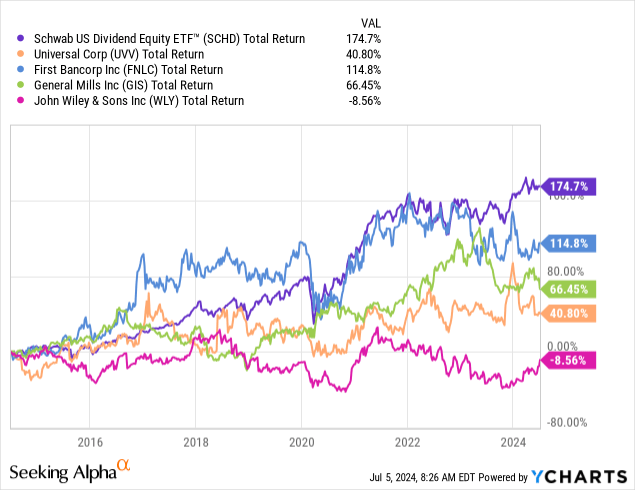Darren415
Welcome back to another edition of upcoming dividend increases, and Happy 4th of July for those in the U.S. This week, we have four more increases, including Dividend King Universal Corporation (UVV). Its 1.25% increase helps extend the company’s 53-year dividend growth streak. The overall group has an average increase of 1.7% and a median of 1.6%.
My investment strategy involves buying, holding, and adding to companies that meet two criteria: consistently increasing their dividends and beating an equivalent benchmark. The information in this article is generated for my investing needs, and I’m happy to share my findings with my Seeking Alpha audience. This list can help you make wise investment choices and create a successful long-term portfolio.
How I Created The Lists
The following information is a result of merging two sources of data: the “U.S. Dividend Champions” spreadsheet from a particular website and upcoming dividend data from NASDAQ. This process combines data on companies with a consistent dividend growth history with future dividend payments. It’s important to understand that all companies included in this list have consistently grown their dividends for at least five years.
Companies must have higher total yearly dividends to be included in this list. Therefore, a company may not increase its dividend every calendar year, but the total annual dividend can still grow.
What Is The Ex-Dividend Date?
The ex-dividend date is when you must own shares to qualify for an upcoming dividend or distribution. To be eligible, you must have bought the shares by the end of the preceding business day. For instance, if the ex-dividend date is Tuesday, you must have acquired the shares by the market close on Monday. If the ex-dividend date falls on a Monday (or a Tuesday following a holiday on Monday), you must have purchased the shares by the previous Friday.
Dividend Streak Categories
Here are the definitions of the streak categories, as I’ll use them throughout the piece.
- King: 50+ years.
- Champion/Aristocrat: 25+ years.
- Contender: 10-24 years.
- Challenger: 5+ years.
| Category | Count |
| King | 1 |
| Champion | 1 |
| Contender | 1 |
| Challenger | 1 |
The Dividend Increases List
The data is sorted by the ex-dividend date (ascending) and then by the streak (descending):
| Name | Ticker | Streak | Forward Yield | Ex-Div Date | Increase Percent | Streak Category |
| Universal Corporation | (UVV) | 53 | 6.8 | 8-Jul-24 | 1.25% | King |
| John Wiley & Sons, Inc. | (WLY) | 25 | 3.47 | 9-Jul-24 | 0.86% | Champion |
| First Bancorp, Inc | (FNLC) | 12 | 5.83 | 9-Jul-24 | 2.86% | Contender |
| General Mills, Inc. | (GIS) | 5 | 3.79 | 10-Jul-24 | 1.69% | Challenger |
Field Definitions
Streak: Years of dividend growth history are sourced from the U.S. Dividend Champions spreadsheet.
Forward Yield: The payout rate is calculated by dividing the new payout rate by the current share price.
Ex-Dividend Date: This is the date you need to own the stock.
Increase Percent: The percent increase.
Streak Category: This is the company’s overall dividend history classification.
Show Me The Money
Here is a table that shows the new and old rates and the percentage increase. The table is sorted by ex-dividend day in ascending order and dividend streak in descending order.
| Ticker | Old Rate | New Rate | Increase Percent |
| UVV | 0.8 | 0.81 | 1.25% |
| WLY | 0.35 | 0.353 | 0.86% |
| FNLC | 0.35 | 0.36 | 2.86% |
| GIS | 0.59 | 0.6 | 1.69% |
Additional Metrics
Some different metrics related to these companies include yearly pricing action and the P/E ratio. The table is sorted the same way as the table above.
| Ticker | Current Price | 52 Week Low | 52 Week High | P/E Ratio | % Off Low | % Off High |
| UVV | 47.66 | 43.16 | 65.9 | 21.46 | 11% Off Low | 27% Off High |
| WLY | 40.67 | 28.27 | 43.72 | 44% Off Low | 7% Off High | |
| FNLC | 24.7 | 20.58 | 27.78 | 10.24 | 19% Off Low | 12% Off High |
| GIS | 63.3 | 59.28 | 75.55 | 15.99 | 7% Off Low | 16% Off High |
Tickers By Yield And Growth Rates
I’ve arranged the table in descending order for investors to prioritize the current yield. As a bonus, the table also features some historical dividend growth rates. Moreover, I have incorporated the “Chowder Rule,” which is the sum of the current yield and the five-year dividend growth rate.
| Ticker | Yield | 1 Yr DG | 3 Yr DG | 5 Yr DG | 10 Yr DG | Chowder Rule |
| UVV | 6.8 | 1.3 | 1.3 | 2.7 | 4.7 | 9.4 |
| FNLC | 5.83 | 3.7 | 4.2 | 4.6 | 5.9 | 10.3 |
| GIS | 3.79 | 8.5 | 4.9 | 3.4 | 4.6 | 7.2 |
| WLY | 3.47 | 0.7 | 10.8 | 1.3 | 3.4 | 4.8 |
Historical Returns
My investment approach involves identifying stocks consistently outperforming the market while increasing dividend payouts. I use the Schwab U.S. Dividend Equity ETF (SCHD) as a benchmark to gauge performance. I use the “Cohen & Steers REIT & Preferred Income Fund” (RNP) for REITs. SCHD has a strong track record of exceptional performance, offers a higher yield than the S&P 500, and has consistently grown dividends. I prefer to invest in the ETF if a stock cannot outperform its benchmark. I have selected several companies for my investment portfolio using this analysis. Additionally, I rely on this analysis to make well-timed additional purchases for my portfolio.
The ten-year dividend growth rate is one of the four main factors in the index behind SCHD. It’s also a proxy for success, although it’s not a perfect predictor. Share prices tend to follow strong dividend growth over long periods, and longer trends will also drown out short-term movements. Here’s a comparison of SCHD versus those with a ten-year dividend growth rate.

Over the past decade, SCHD returned approximately 175% (dividends are reinvested in all these results). Unfortunately, the entire comparison group dramatically underperformed SCHD. The best of the bunch was FNLC, at 115%, with the worst being WLY, with a negative 9% return over a decade! GIS and UVV finished in the middle, with 66% and 41% returns, respectively.
Next Steps
After reviewing each company’s stats and total return performance, I’m passing on looking closer at anyone on the list. Unfortunately, each company’s return profile dramatically underperformed the index I use for dividend growth stocks.
Looking back at some of the dividend growth metrics above, the lack of performance shouldn’t have been a tremendous surprise.
| Ticker | 10 Yr DG |
| UVV | 4.7 |
| FNLC | 5.9 |
| GIS | 4.6 |
| WLY | 3.4 |
Here’s a miniature version of the companies and their 10-year dividend growth rates. CAGRs in the 3-4% range don’t tend to be the best-performing companies over time. From past research, the strongest performers tend to have 10-year CAGRs in the double-digit range. It’s a general rule of thumb, and it will not be universal. In any event, I’m passing on this group and looking forward to the set next week!
Let me know what you think of my strategy, and feel free to add yours in the comments below! As always, please do your due diligence before making any investment decision.

